A brick house in Singapore shared by three generations of a family
After bringing up his children on this plot, a retired homeowner now grows old with his grandchildren in a newer, larger house on the same piece of land.
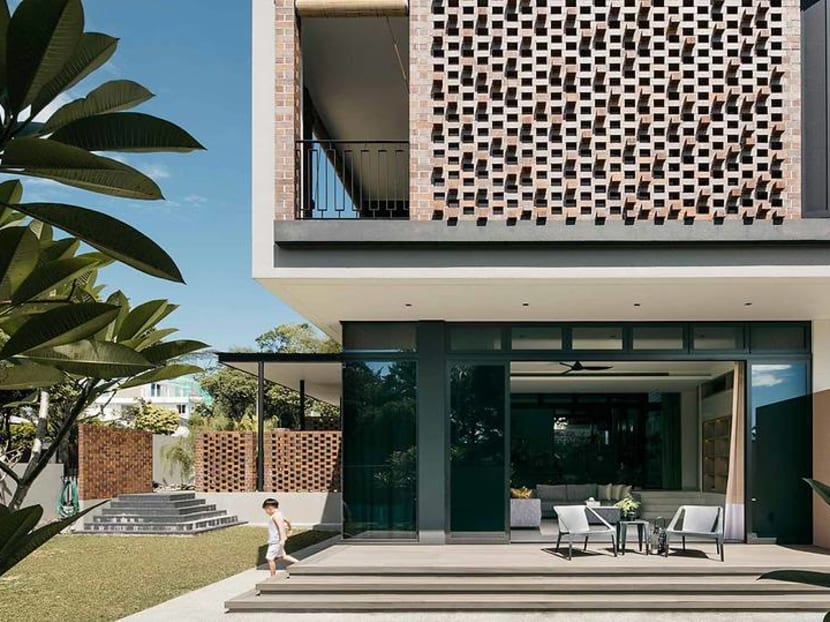
The facade of this multi-generational family home is characterised by a layered brick facade. (Photo: Studio Periphery)
Twenty-eight years ago, a couple bought a house built in the 60s to bring up their two children in. Clad in brick, it had charm and tactility. The interiors were breezy due to its location on the peak of a hill and there was a large garden for carefree running and playing.
The owner enjoys the peaceful and breezy neighbourhood, which is surrounded by nature. “You can see and hear different types of birds chirping and singing, and squirrels running from tree to tree every morning. It is like we are living in the countryside or a resort although we are not far from the city,” he said.
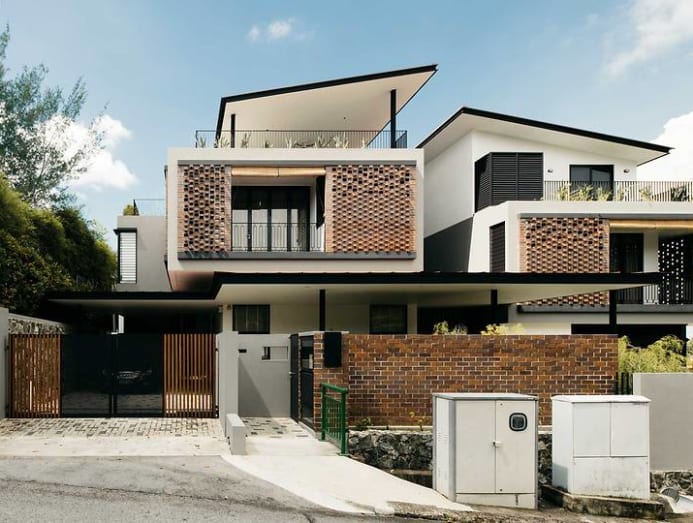
READ> In Singapore, this father built a family home for his three daughters to enjoy
When the children left to study overseas, the owner rented the property to a childcare centre. A few years ago, he decided to live in it again but wanted a new house to accommodate the needs of his daughter and his family who would stay with him. He also decided to maximise the footprint for potential investment purposes.
He engaged The Design Abode, who worked with WKL Architects on the project. The Singapore-based firm has designed many homes as well as several hospitality projects, including Natra Bintan (formerly The Canopi) – a glamping resort in Bintan.
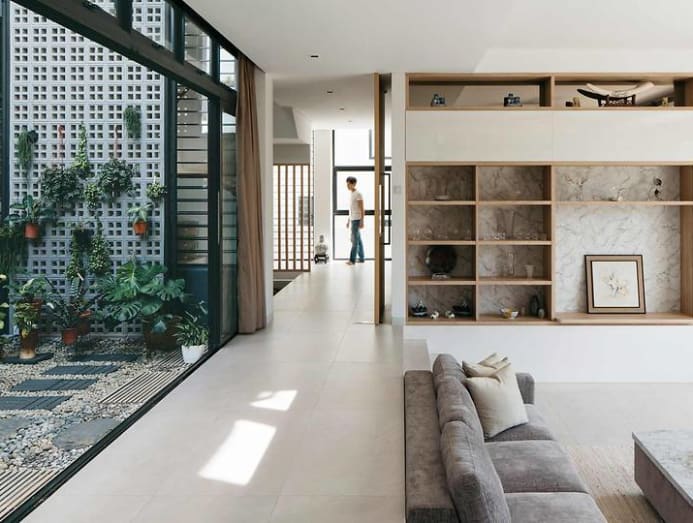
Following the owner’s request, the firm’s founder Ewan Wong and its director Adrian Ong (who has since left the company) first relocated the driveway to the other road-facing side of the corner plot. The original entry was close to the junction and driving into the house was inconvenient.
The driveway’s relocation also means the living room now faces a more expansive garden. “We enjoy nature and greenery, so having to keep a large portion of the land for landscaping was important to us. We like gardening and growing our own edible plants. I also enjoy taking my morning and evening strolls around my own garden,” said the owner.
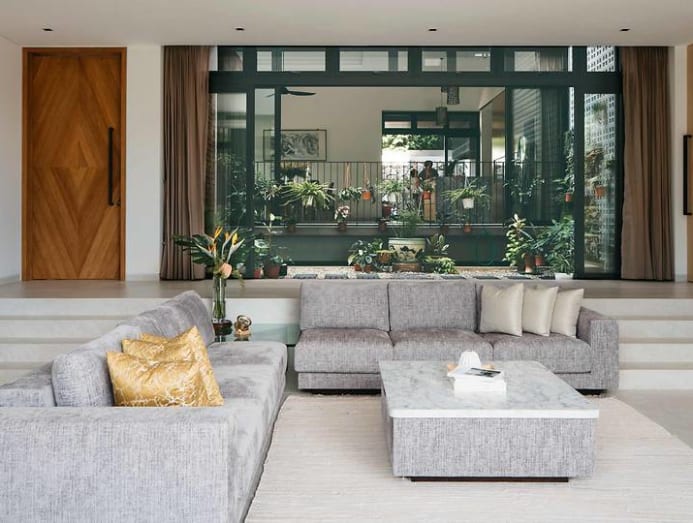
The new plan reads as two blocks – one for each family – glued in the centre with an open courtyard. The blocks’ staggered levels trace the slope’s natural topography. “The stair and lift core was then inserted in between to weave the levels together,” explained Wong.
On the lower side of the first storey is the common living room and guest room, which can become a “granny room” in the future should the owner and his wife decide to live downstairs in their later years.
In the living room, there is no television as the owner believes this space is for bonding. The dining and kitchen are in the higher block next to the new driveway.
“We enjoy nature and greenery, so having to keep a large portion of the land for landscaping was important to us. We like gardening and growing our own edible plants.” – The homeowner
READ> In Singapore, two siblings build a home next door to their parents to foster familial ties
INTERNAL AFFAIRS
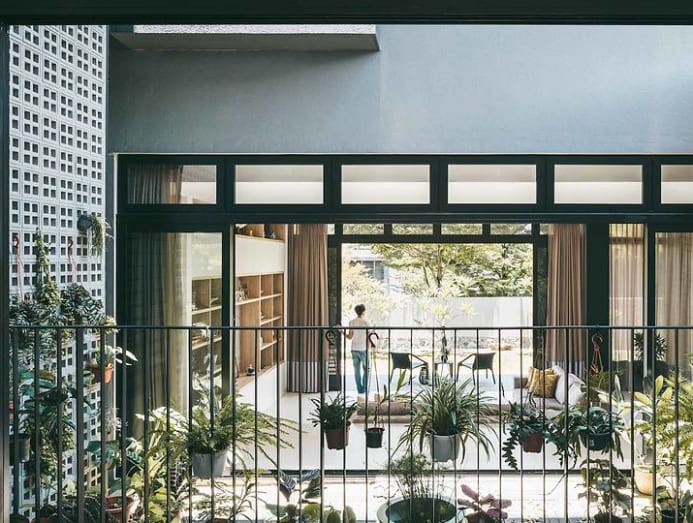
The courtyard is an important part of the internal experience. It connects the two zones across the different levels with windows looking in, as well as enhances privacy, daylight and ventilation for the internal spaces. The outdoors is brought in with landscaping, which the daughter described as her circuit breaker project.
“We tried to grow grass but it did not grow. So I started growing [other plants] in pots. They survived very well like this and are easier to maintain,” shared the daughter – a freelance interior designer who contributed to the project with her expertise.
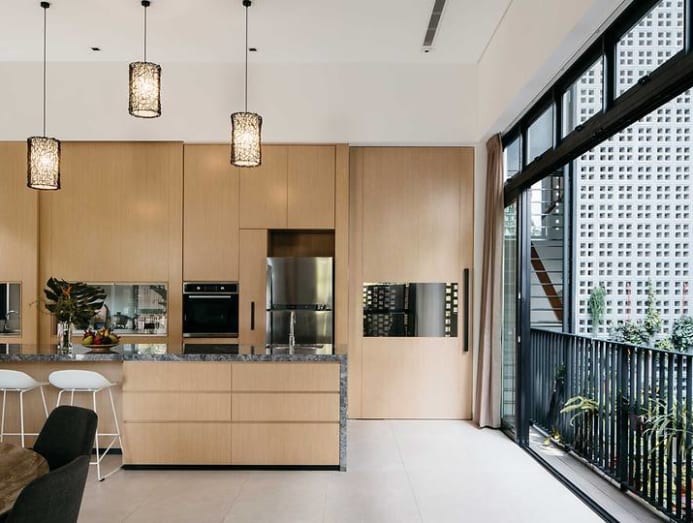
Her father also had his own initial plan for the courtyard, which was shelved. “I thought of constructing a fish pond with edible fish like tilapia so that when friends come over, I can fish them out and cook them like in a seafood restaurant,” he shared.
The hassle of building infrastructure and hiring an engineer to work on the task deterred him. Now instead, there is a large pot with small fish, which is just as charming.
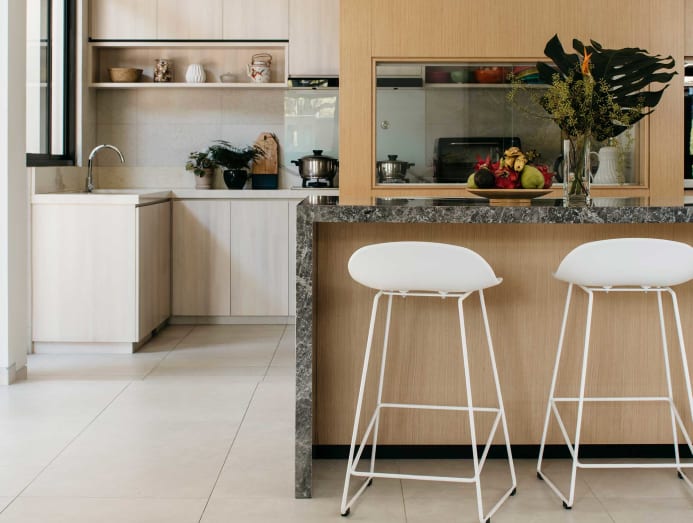
From the living room side, a slit window to the basement can be seen at the courtyard. “The basement was designed to be a movie or karaoke room but now we’re not maximising the usage of the entire house so it’s just used for storage,” said the owner.
Behind the courtyard is another garden – this time, a rock garden that adorns the base of the staircase. “This was sentimental because some of the rocks and the stone pagoda is from my grandfather’s house,” said the daughter. Some of the large rocks were discovered on site when the builder tore the house down and excavated the soil for the basement.
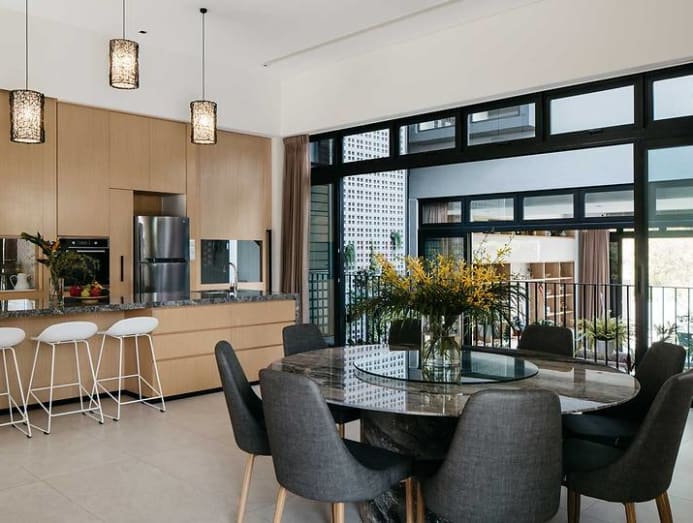
READ> House tour: A cave-like home in Singapore designed for the simple life
LEVELLING UP
The owner and his daughter’s bedrooms are located on the second storey, separated by half a level. They are almost symmetrical in plan except for some programmatic differences relevant for the two households.
“Each family has its own space so we don’t infringe on one another. My daughter and son-in-law’s friends can hang out on their side and if my friends want to watch football with me, they can come to my family room on the second storey in my wing,” said the owner on how the home’s design accords privacy to each family.
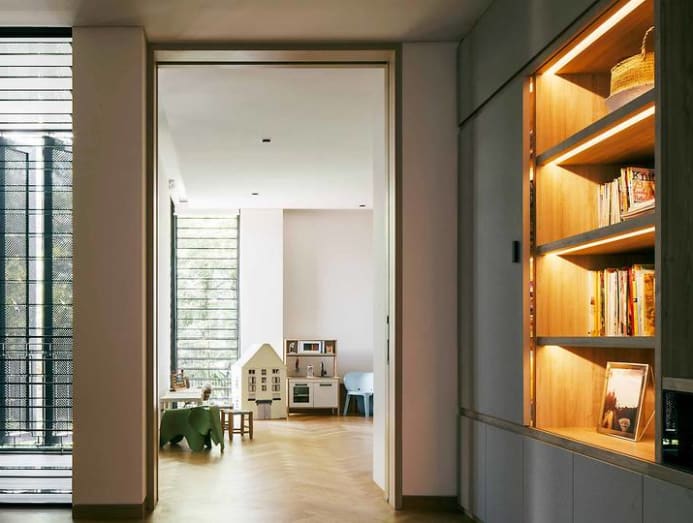
Aside from the bedroom and bathroom, there is a family room, study room and prayer room in the owner’s wing. In the daughter’s wing, there is a small bedroom and bathroom for her two pre-schoolers, as well as a large study that is currently a playroom.
“I call the children’s bedroom the nursery because when they are young, they can sleep here but when they get older, they can sleep in their own rooms,” said the daughter.
In the attic are three small bedrooms with en-suites allocated for this purpose. They are currently unused. “When you build a house, you think of a ten- to twenty-year plan,” explained the daughter.
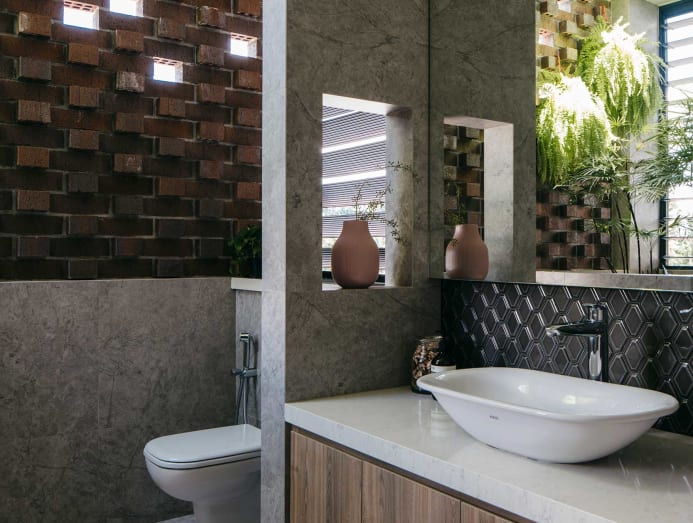
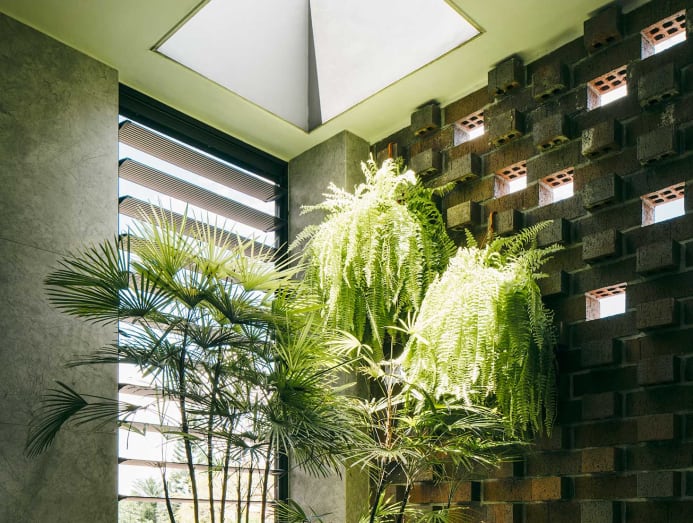
In the new house, Wong inserted a balcony but it now goes around the house on the second storey, and functions as an external corridor outside the rooms or a space to enjoy the tropical weather under shelter.
A facade of alternating perforated, aluminium and brick screens wrap this semi-outdoor space, giving the interiors privacy.
“The brick screens are reminiscent of the old fair-faced brick house. We explored a layered brick pattern, meticulously laid by the builder CapitalGold,” explained Wong.
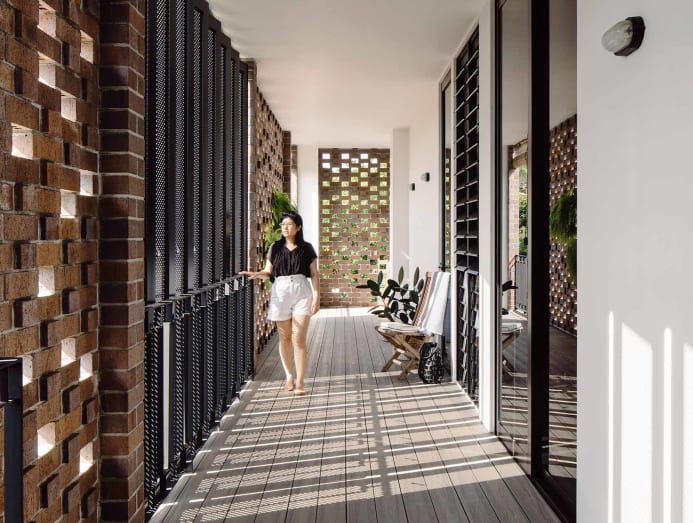
The perforations are reduced when facing direct sunlight, and more porous where it faces away from the sun. They are also good for natural ventilation. “It is so breezy here that we don’t sleep with the air-conditioning. We just sleep with the windows open,” said the daughter.
When it gets especially stormy or windy, she even has to tie the shutters down, as they are not lockable. The porous brick walls continue to clad the bathrooms of the owner and his daughter. In each, an elevated planter capped with a skylight gives the occupants the feeling of showering outdoors.
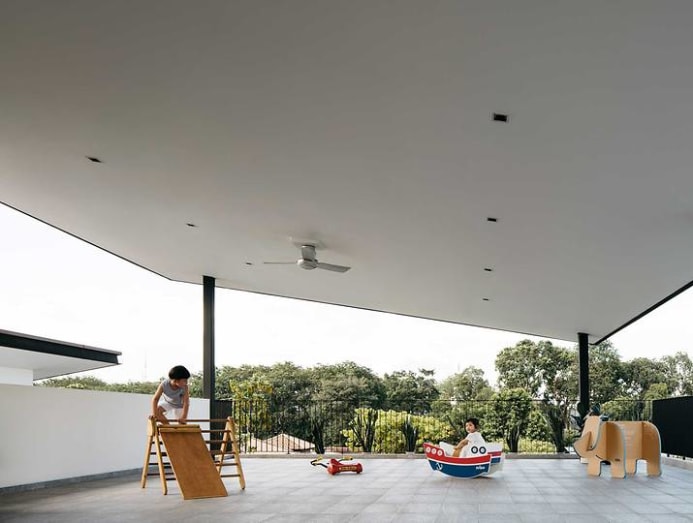
Half a flight up from the attic bedroom is a generous roof terrace that is sheltered but open at the sides. Offering unblocked views all around, it is another wonderful space for both communal and solitary activities.
The children can play here, and the family watched the National Day fireworks from here this year. Meanwhile, the owner, armed with just his mobile phone, comes regularly to take postcard-like photographs of brilliant sunsets in myriad hues.



